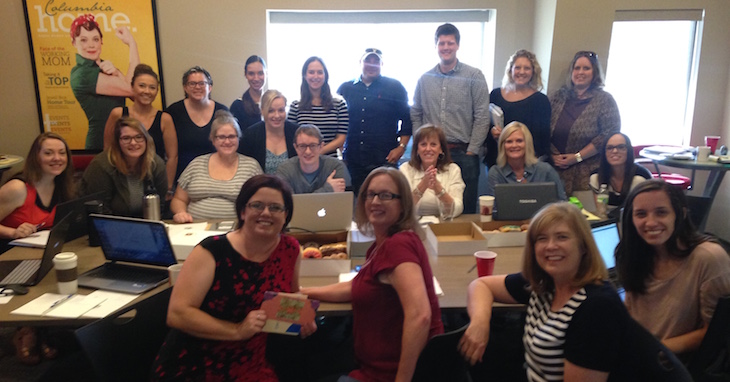Who’s Who of 1985
The definition of influence is short enough: the capacity to have an effect. The act, though, is a tall order. It takes a whole lot of hard work, strong character and the power to effect change.
The CBT took a look at some of Columbia’s local leaders from 1985 who, for better or worse (and mostly better), left a lasting impression on our community. Here’s to Columbia’s most influential people of 1985!
Bill Dye
By Claire Boston
As the city’s first black police chief, Bill Dye came to Columbia in 1982 after a nationwide search. Prior to moving to Columbia, Dye worked as the chief of police in Champaign, Ill., where he focused on recruiting minorities and instituting a neighborhood watch system.
In 1985, Dye was named as one of seven defendants in a multimillion-dollar lawsuit relating to the death of Kimberly Linzie, who was shot to death by Columbia Police officers in 1985. Linzie’s death caused controversy in the city, as some residents believed the shooting to be racially motivated. The suit claimed that Dye had not adequately trained his officers in use of force and failed to follow up on complaints of police misconduct.
Dye suspended the officer involved in the shooting. A U.S. Justice Department-ordered FBI investigation later concluded the officer was justified in shooting because he believed Linzie was about to run over another officer. The suit was settled in 1987.
Dye left the Columbia Police Department in 1987 and took a position as director of security at Texas Southern University. He died in Texas in 1994. He was 60.
Don Ruthenburg
By Madison Alcedo
When Donald Ruthenberg became the 15th Columbia College president in July 1984, the college was $1.6 million in debt. In September 1984, the college was completely free of federal indebtedness thanks to its former board of trustees and 70 other individuals who helped raise the $586,247 needed to get the college out of its debt.
Ruthenberg received a doctorate in education from the University of Denver. From 1980 to 1984, he supervised about 25 Iowa colleges as the Iowa Association of Independent Colleges and Universities president. In 1972 to 1980, he was also the president of Southwestern College in Winfield, Kan.
During his term at Columbia College, Ruthenberg not only regained financial stability for the college, but he also oversaw the Southwell Complex project that housed a new gym for the basketball and volleyball teams in 1988, completed the J.W. and Lois Stafford Library in 1989 from more than $280,000 in donations, finished continuous renovations on campus and created international ties and sister-college relationships with three Taiwanese colleges. After heading Columbia College for 11 years, Ruthenberg retired in 1995. His last duty as Columbia College president was awarding a Bachelor of Arts degree to his daughter. Upon retirement Ruthenberg moved with his wife, Dee, to the Lake of the Ozarks.
Jerry McAhren
By Torie Ross
Jerry L. McAhren served as the regional vice president of State Farm’s Missouri-Kansas office from 1985 until 1989. McAhren started his career with State Farm in 1961 as a management development trainee in data processing at the Missouri-Kansas office located in Columbia.
Before becoming regional vice president of that same office, McAhren served as superintendent of regional data processing operations and director of stat processing at State Farm’s corporate headquarters in Bloomington, Ill. McAhren then returned to the Columbia office as regional vice president, the company’s top corporate leader in Missouri. When State Farm opened its Oklahoma-Kansas office in Tulsa in 1989, McAhren was named to the same position in that office and transferred.
John O’Shaughnessy
By Claire Boston
John O’Shaughnessy served as president of Boone Hospital Center from 1985 to 1992. During his tenure, he oversaw the 1988 transition of hospital administration from Boone County to Christian Health Services.
A decline in profits in the mid-1980s led O’Shaughnessy to seek out an administrative leaser. Boone County retained ownership of the hospital, though Christian Health Services took over day-to-day administration. The agreement eliminated a county tax on Boone County residents.
Christian Health Services became BJC HealthCare following a merger. BJC HealthCare still administers the hospital in accordance with a lease agreement that extends through 2015.
O’Shaughnessy arrived at the hospital center after running Children’s Mercy Hospital in Kansas City. Earlier in his career, he was the administrator of the Medical Center of Independence and worked with the St. Louis hospital system. Although he called the health center strong when he first took the president job, O’Shaughnessy strove to make the hospital more participatory for staff.
O’Shaughnessy left the hospital in 1992 to become president of Christian Hospital in St. Louis. Later in his career, he returned to Columbia to be an administrator with MU Health Care. O’Shaughnessy retired in 2010 after five years as the administrator for the St. Louis Shriners Hospital for Children.
Patsy Sampson
By Claire Boston
Patsy Sampson, president of Stephens College from 1983 to 1994, was the first female president at the women’s college. Stephens’ enrollment tumbled by nearly half during Sampson’s tenure. Enrollment was below 590 when Sampson announced her resignation in 1993, down from 1,063 in 1983. The enrollment woes forced Sampson to trim the college’s budget and eliminate administrative and faculty positions.
During her time, Sampson fought to save the college’s historic Senior Hall, the oldest building on campus. She helped the school fundraise $3.5 million for renovations and worked on cultivating relationships with wealthy alumnae capable of giving major gifts to the college.
Sampson came to Stephens from Drake University in Iowa, where she was the dean of the College of Liberal Arts and a psychology professor. She had also served as a dean at Pitzer College in California and worked at Binghamton University and Wellesley College.
In her retirement, Sampson devoted much of her time to traveling around the world. She died in Albuquerque, N.M., in 2009 at 77.
C. (Claude) Peter Magrath
By Torie Ross
C. Peter Magrath, who has made a career of being a university president, presided over the University of Missouri System from 1985 until 1991. Magrath previously served as the president of Binghamton University from 1972 until 1974 and as president of the University of Minnesota from 1974 until 1984.
During his six years at the helm of the UM System, Magrath implemented improvement strategies for eight programs across the system that were aimed at raising those particular programs to levels of national and international eminence. The three programs on Columbia’s campus that were part of the “eminence program” were journalism, molecular biology and Food for the 21st Century. After leaving the university in 1991, Magrath became president at West Virginia University from 2008 until 2010 and then returned to Binghamton University, where he has served as president since 2010.
Rodney Smith
By Madison Alcedo
Mayor Rodney Smith, a tree-surgeon known for his casual talk, boot-wearing and sympathy for his fellow working class, took over the mayoral position in May 1985 when Mayor John Westlund resigned after facing criminal investigation for his $12,000 worth of dubious travel expenses. Former Columbia City Council members praised Smith’s honesty and integrity, which was especially important for the city after his predecessor’s scandal.
Smith was born in Freeman, Mo., and was a graduate of the Davey Institute of Tree Surgery in Kent, Ohio, which led to the opening of his own business, Rodney D. Smith Tree Service, in 1959. Smith won his first City Council seat in 1971 and was later elected as the 3rd Ward councilman in 1979, a position he held for eight years.
For years Smith would meet people at five or 10 homes every day through his tree-trimming business, which contributed to his popular appeal. Former 4th Ward Councilman Pat Barnes once said: “Rodney is kind of a people’s mayor. He may not be the most articulate, he may not be the most shined politician, but he’s the people’s mayor.” Until the end of his term in 1988, Smith ushered in a new era in Columbia’s city government.
Russell Thompson
By Torie Ross
Russell V. Thompson was the superintendent of the Columbia Public Schools system for 18 years, the longest tenure as superintendent in the district’s history. Thompson, who began his career in education as a teacher at Hickman High School and later as the school’s principal, became superintendent in 1976. During his 18 years serving the school system, Columbia was recognized as one of the nation’s top 16 model school districts by the National Governor’s Conference on Education.
Thompson also played an essential role in growing and maintaining several of Columbia’s nationally recognized educational programs, including Parents as Teachers and Partners in Education. Thompson moved on to serve on the State Board of Education in 1994. He served two terms on the board and an additional two terms as the president of the board, from which he retired in 2010.
Thompson has received several awards for his accomplishments, such as the Lifetime Achievement Award from his alma mater Northwest Missouri State University and the National Education Administrator of the Year award by the National Association of Educational Office Professionals.
Ted Boehm
By Madison Alcedo
After 14 years as a trooper with the Missouri State Highway Patrol, Ted Boehm couldn’t get law enforcement out of his system and decided to run for the Boone Country sheriff position.
Boehm began as a trooper in 1967 and retired for financial reasons in 1981 after retaining the rank of corporal. With 1,500 hours of training at the Highway Patrol Academy, Missouri’s 120-hour police course and experience working closely with the Sheriff’s Department, Boehm was an ideal choice for sheriff. With the exception of a homicide, he had investigated every type of crime a sheriff might be expected to encounter prior to being elected.
Boehm won the 1985 election with a 3-1 victory over republican Tom Watson, and within the first three weeks of becoming sheriff, he had already begun reorganizing the department by implementing new policies for patrol, conducting employee evaluations and pushing for a state law requiring jail employees to be certified. Over the course of his term until its end in 2004, Boehm modernized the Sheriff’s Department; he improved its morale and image by purchasing new uniforms, squad cars and revolvers and redesigned the county jail. Once he addressed the department’s uniformity: “If one of us wears a hat, we’ll all wear a hat.”
Bo Fraser
By Claire Boston
In his more than 20 years as CEO and chairman of Boone County National Bank, Bo Fraser maintained close ties to his community during a period of banking upheaval. Fraser joined the bank as president in 1983. After 18 years as president, he turned over presidential duties to Steve Erdel in 2002 but stayed on as CEO and chairman until he retired in 2006.
As many banks deregulated in the 1980s and shifted their attention to offering new kinds of financial products, Fraser kept BCNB community focused. Over the years, he acquired a number of smaller community banks to expand BCNB’s branches and sprinkled more ATMs throughout the city. At the time of his retirement, BCNB’s assets topped $1 billion, up from less than $300 million when Fraser began.
Even in his retirement, Fraser remained active on the BCNB board and served as board chairman. He also spent two years on the UM System Board of Curators, though he left his post early to spend more time at his retirement house in Florida.
Robert Smith
By Madison Alcedo
In 1979 Robert Smith was appointed MU Medical Center hospital director after four years as hospital director at the University of California Medical Center at Davis. A Downey, Calif., native, Smith received a bachelor’s degree in business administration from California State University in 1963, a master’s degree in business administration from California State at Long Beach in 1970 and completed Ohio State’s graduate certificate program in hospital and health services in 1978.
Less than two weeks after taking his position at MU’s hospital, Smith implemented a restructuring plan for the institution’s administration. As MU’s hospital director for 13 years until 1992, he revitalized a hospital that was once perceived as an “out-of-date hospital with some serious problems” by revamping the hospital’s structure, recruiting nurses to alleviate the nursing shortage and hiring a new financial officer.
Also during his tenure, Smith oversaw the merger of the Ellis Fischel Cancer Center with the hospital. In 1992 Smith took MU’s early retirement plan to accept the job of president and CEO of the Zale Lipshy University Hospital at Southwestern Medical Center in Dallas.
Jack Nowell
By Torie Ross
Jack Nowell, co-founder and owner of the Nowell’s Grocery Store chain in Columbia, came from a family of grocers and shop owners. Nowell’s grandfather owned a sandwich shop in downtown Columbia for decades, and his father and uncle owned a wholesale grocery company that supplied local supermarkets with produce. When Nowell left the Army in 1944, he immediately joined the family business. He opened the first Nowell’s Grocery Store in 1957, and at the time of his death in January 2000, Nowell owned three stores in Columbia, one store in Hollister, Mo., and one in Branson, Mo.
Nowell and his company are best remembered for innovation in a changing business landscape. In 1977 Nowell’s Grocery Store provided Columbia with its first computerized checkout scanners, speeding up the checkout process and forever changing the way grocery shopping was conducted in Columbia.
Throughout his career, Nowell served as president of the Downtown Rotary Club and the Columbia Chamber of Commerce. He also served on the board of directors for First National Bank.
Interesting fact about Jack Nowell: He played on the undefeated 1935 Columbia High School football team with Sam Walton of Walmart.
Jack Pettit
By Madison Alcedo
Gus Lehr, former president and CEO of Shelter Mutual Insurance Co. (formerly MFA Mutual Insurance Co. and now Shelter Insurance Co.), stepped down as president in 1984 for Jack Pettit to take over the role of president. Lehr remained CEO and chairman of the board while Pettit helped Shelter increase its net income by $54 million in 1985, after the company operated at a loss the two previous years, losing $16 million in 1984 alone.
At the time, Shelter was the largest private employer in Columbia, and with 1,022 employees. Petit took a look at what happened in the industry and decided to change some of the company’s operations, a decision that he said had other insurance companies inquiring about the changes they made.
Pettit grew up in Columbia, attended Hickman High School and was a graduate of the MU School of Law. Pettit started with the MFA Mutual Insurance Co. in 1949 and was one of its first employees. He retired as Shelter’s president in 1989 and passed away in July 2009.
Ray Beck
By Torie Ross
Former City Manager Ray Beck, who held in that position from 1985 until his retirement in 2005, served with 14 different mayors in Columbia. Beck began his career with the city in 1960 and held a variety of positions, including Water and Light director.
During his tenure as city manager, Beck oversaw the implementation of a city-operated waste removal system, a municipally operated public transit system and an expansion of the local parks and recreation services. Throughout his career with the city and even post-retirement, Beck held close ties with a variety of organizations, including the National Recreation and Parks Association, University of Missouri Dean’s Engineering Advisory Council and the Missouri Highways Engineers Association.






